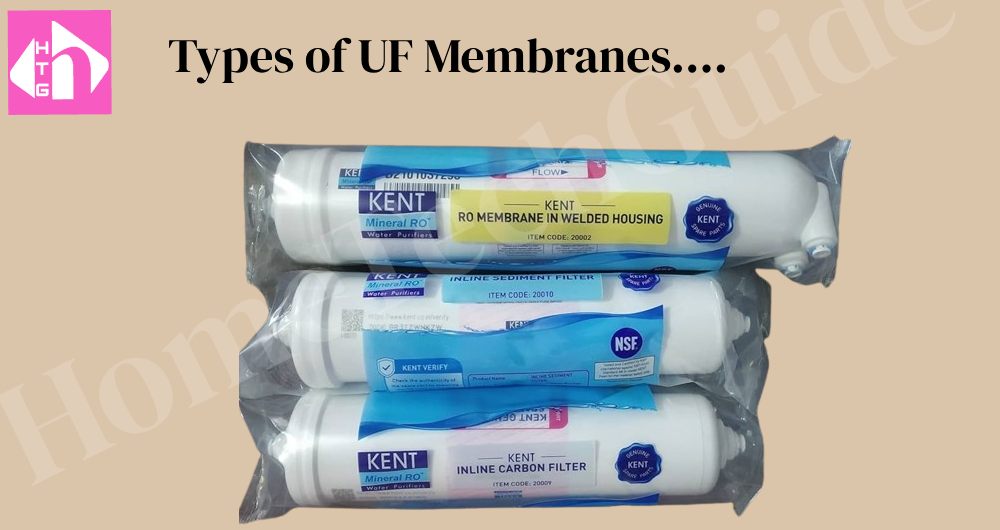Understanding what is UF in water purifier is similar to understanding the base to water purification technologies over the years. Purifying the water we drink is a crucial need in 2024 and ultra-filtration technology is serving this crucial need efficiently across the globe.

Among the various water purification technologies, Ultrafiltration stands out for its efficiency, effectiveness, and user-friendliness. This article explains what UF is in water purifiers, how it works, when should one use UF water purifiers, what are the advantages of using UF water purifiers, and how one should maintain them.
Let’s Start with understanding Ultrafiltration technology, first.
Understanding Ultrafiltration (UF)
Ultrafiltration, abbreviated as UF, is a water purification technology that employs passing water particles through the tiny pores of a semipermeable membrane. These tiny pores are small enough to block the contaminants in water, allowing only the clean purified to pass the membranes. UF water purification technology operates at the molecular level on the principle of exclusion by size. The membrane pores are as small as in the range of 0.1 to 0.01 microns.
Let us now define what is UF in water purifier?
What is UF in Water Purifier?
UF in water purifiers symbolizes water purifiers that use Ultrafiltration technology to clean the water. This technology can come alone or as a combination of UF +UV or UF+UV+RO in a water purifier. Users may buy one that suits the purification needs of water in their areas. The term UV here indicates Ultra Violet rays embedding technology used to kill biological impurities in water, and RO indicates Reverse Osmosis technology for water purification.
Importance of UF in Water Purifiers
As we mentioned above UF may come as a solo technology in a water purifier or combination with others. It plays a vital role in enhancing the efficiency of water purifiers with its high filtration effectiveness. They account for protecting the RO membranes from directly interacting with colloidal impurities, enhancing the life of RO membranes, and saving the replacement cost for the users.
Depending upon the needs, buying the UF alone water purifiers is less expensive. However, we recommend using a combination of UF and UV to ensure the water is free from both the colloidal and the biological impurities.
UF membranes can remove particles as small as 0.01 microns, making them highly effective in eliminating bacteria, viruses, protozoa, and other microorganisms in water. Besides removing impurities, UF in water purifiers improves the taste, odour, and clarity of the water.
Let us now move on to understanding the advantages of ultrafiltration in water purifiers.
Advantages of UF in Water Purifiers
The advantages of UF in water purifiers include:
- Retention of Minerals: UF water purifiers are capable of retaining minerals such as calcium, magnesium, and potassium in the water, making the purified water healthy, tasty, and balanced for health needs. This attribute is usually poor in high-end purification technologies like the RO. RO technology for water purification essentially removes much of the minerals, dropping the TDS level to below essential health needs.
- Energy efficiency: UF water purifiers filter the sediments at gravity pressure, making them highly energy efficient. These water purifiers do not need electricity for their operation and can be used in areas where with frequent power failure issues.
- Cost-effectiveness: UF purifiers are less expensive compared to other water purification technologies. Also, due to their simple design and low maintenance needs, UF purifiers are highly cost-effective in the long run.
UF offers several advantages that make it a preferred choice for water purification systems in both residential and commercial settings. Allow us to reiterate our recommendation to use the UF water purifier only when the input water conditions in your area support its compatibility. The standards for the drinking water quality can be found at https://bis.gov.in/index.php/standards/
Note: UF water purifiers are not designed to remove the dissolved solids in water. As a result, the TDS content of water after purification remains, more or less, the same as what it was before. TDS under the specified limit is good for our bodies but if the limit exceeds, depending on the TDS content of input water, users should go with a combination of UF+UV+RO water purifiers.

Types of UF Membranes
UF membranes come in two types:
1)Hollow Fiber Membranes,
2)Spiral Wound Membranes.
Both of these membrane types have their unique characteristics and applications. Let us understand them one by one.
- Hollow Fiber Membrane: These membranes consist of thousands of tiny hollow fibres bundled together. They are commonly used in compact and portable UF water purifiers.
- Spiral Wound Membrane: These membranes come in a spiral configuration, enhancing their efficiency and making them perfect for large-scale water purification. They are popularly utilized in commercial and industrial settings.
Applications of UF in Water Purification
As mentioned above, UF membrane types account for their application compatibility in various settings. In one way or another, they find extensive application in both residential and commercial water purification systems, including as combinations with UV and RO systems for water purification. Here are a few usage examples:
- Residential Use: UF water purifiers are good kitchen appliances for households receiving the supply of water from municipal corporations. The carry-over contaminants while transportation through pipes can be removed effectively with UF water purifiers.
- Commercial Use: In commercial places such as restaurants, hotels, hospitals, and offices, UF water purifiers can ensure quality water for various purposes, including drinking, cooking, and testing(LABS) use.
Let us now move to understanding the maintenance needs and procedures for UF water purifiers.
Maintenance of UF Water Purifiers
Proper maintenance is essential to ensure the optimal performance and longevity of UF water purifiers. The steps to maintain the UF water purifiers include:
- Cleaning the UF membranes: Cleaning the UF membranes regularly is crucial to preventing contaminants buildups. This also maintains or enhances the efficiency of the water purifier. The membranes can be cleaned with some suitable soap solution and backwashing under the running water.
- Membrane Replacements: Everything has a life and so do the UF membranes. Despite being durable in the long run, ensure checking the membranes for wear and tear and replacing them on time to safeguard your family from impure water consumption. The input water quality has a direct effect on the UF membranes and despite being a good quality, UF membranes may not last proportionately at all locations.
Let us now compare UF in water purifiers with other technologies. This would help you understand the related context and make a superior decision when buying a water purifier.
UF vs. Reverse Osmosis (RO)
Both the UF and the RO water purification technologies can effectively remove contaminants. While RO membranes have smaller pores and can remove dissolved solids, including minerals, UF membranes retain minerals and operate without the need for electricity.
UF vs. UV Purification
UF physically removes contaminants from water, whereas UV purification uses ultraviolet light to kill biological impurities, including bacteria, fungi, protozoa, and other microorganisms. On the other hand, UV water purifiers kill biological impurities but it does not remove particles or impurities from water.
Conclusion:
Understanding what is UF in water purifiers is a conventional root to understanding the basic technology employed in mankind’s history to purify drinking water. The technology has evolved with time and is an essential component of households in 2024.
A thorough understanding of the principles and applications of UF in water purifiers would help buyers make informed decisions when choosing a water purifier.
We believe our guide on what is UF in water purifiers was simple to understand and you loved it. If you still have some queries, please ask us through the comments section below. Please share this report with your loved one if you find it insightful.
Thank you!
FAQs
What all can UF remove in water?
UF membranes can remove bacteria, viruses, protozoa, suspended solids, sediment, rust, chlorine, pesticides, and other impurities from water.
When to replace the UF membranes?
The replacement frequency for UF membranes may depend on the quality of UF membranes and the input water quality. We suggest following the manufacturer’s recommendations for replacing the UF membranes. Also, please ensure checking the membranes’ status periodically for wear and tears and replace them if needed.
Is UF enough to purify all types of water?
While UF is effective in removing a wide range of contaminants, it may not be sufficient to purify highly contaminated or chemically polluted water. In such cases, additional treatment methods may be required.
Can UF purifiers desalinate seawater?
UF membranes are not designed to desalinate seawater.
